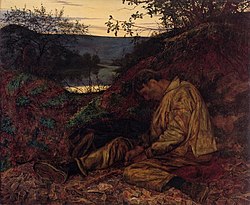Henry Wallis
Henry Wallis (born February 21, 1830 in London , † December 20, 1916 in Croydon , Surrey ) was a British painter in the style of the Pre-Raphaelite .
Life

Henry Wallis was born out of wedlock in 1830 to Mary Anne Thomas; his father is unknown. It was only when his mother married the wealthy London architect Andrew Wallis in 1845 that he took the surname Wallis after his stepfather.
Between 1848 and 1853 Henry Wallis trained as a painter at the Royal Academy of Arts in London and at the Académie des Beaux-Arts in Paris. In Paris he also became a student of Charles Gleyre . Wallis exhibited for the first time in 1853.
After the death of his stepfather in 1859 he inherited a considerable fortune and was able to undertake extensive trips abroad, during which he devoted himself to his interest in archeology , ceramics and the Renaissance . Since then he has been less prominent as a painter. Wallis died unmarried in 1916 and was buried in Highgate Cemetery in London.
plant
Wallis' first great success and at the same time his main work is the painting "The Death of Chatterton" ( The Death of Chatterton , 1856, now in Tate Britain ). Thomas Chatterton , a young poet who had desperately committed suicide in 1770 at the age of only 17, was a romantic idol for many young and not yet established artists in the 19th century. Walli's affinity for the Pre-Raphaelites is evident in this painting in the bright colors and in the careful design of the often symbolically significant details. The picture made Wallis famous overnight; critic John Ruskin called it "flawless and wonderful". In Wallis' painting, the poet George Meredith served as a model for Chatterton; two years later (1858) Meredith's wife left her husband to begin a relationship with Wallis.
Walli's oil painting “Der Steinklopfer” ( The Stonebreaker , 1857, Birmingham Museum and Art Gallery), which shows a collapsed quarry worker at sunset, was also very well known . Although the man only seems to be asleep at first glance, fine pictorial symbolism suggests that he rather died of exhaustion. The picture was later z. Sometimes interpreted as Wallis 'turning away from the Pre-Raphaelites towards an early Victorian "social realism", on the other hand, however, it was precisely this painting that cemented Wallis' reputation as a true Pre-Raphaelite.
Henry Wallis published his research results on Persian, Egyptian, Greek and Byzantine ceramics in twenty volumes from 1885 to 1899.
literature
- Robin Hamlyn: Wallis, Henry (1830-1916). In: Henry Colin Gray Matthew, Brian Harrison (Eds.): Oxford Dictionary of National Biography , from the earliest times to the year 2000 (ODNB). Volume 57: Walliers-Welles. Oxford University Press, Oxford 2004, ISBN 0-19-861407-1 , pp. 13f., ( Oxforddnb.com license required ), as of January 2008
Individual evidence
- ↑ See Henry Wallis at Artmagick ( Memento of the original from August 19, 2010 in the Internet Archive ) Info: The archive link was inserted automatically and has not yet been checked. Please check the original and archive link according to the instructions and then remove this notice.
- ↑ J. Treuherz: Hard Times: Social Realism in Victorian Art , London 1987, pp. 36-39.
- ↑ Robin Hamlyn: Henry Wallis , as stated in the literature above, p. 14.
| personal data | |
|---|---|
| SURNAME | Wallis, Henry |
| BRIEF DESCRIPTION | British painter |
| DATE OF BIRTH | February 21, 1830 |
| PLACE OF BIRTH | London |
| DATE OF DEATH | December 20, 1916 |
| Place of death | Croydon , Surrey |
